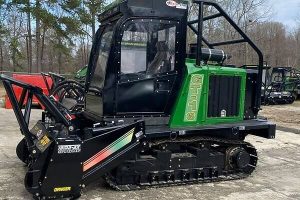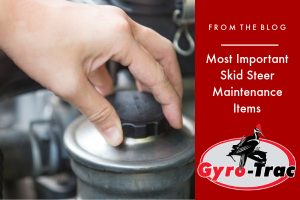How to Choose A Skid Steer Loader
When choosing a skid steer, you need to make sure you pick the right skid steer for your application.
Whether you're looking to buy your first skid steer to support a new business endeavor or you want to upgrade to a better model so that it can support more attachments to streamline efficiency and productivity, selecting such a vehicle is a lot more complicated than you might think.
Think of it in the same way that you would select a new car or truck in that you're not just going to visit the dealership and play "Eenie Meenie Miney Mo." First, you're going to do some research on models that you like, then visit the dealership to learn more about the vehicle's features and amenities. You'll test drive it to get a feel for being behind the wheel and you might even take a look under the hood.
Selecting a new skid steer should follow a similar process, and it all starts with doing your homework so that you know what type of model works best for your situation and the types of attachments that you want to outfit it with. In other words, just like a new car or truck, not all skid steers are one and the same.
In this post, we'll cover some of the key considerations that you should be weighing to determine the type of skid steer that can help boost your productivity out in the field. Here's a closer look:
5 Things to Know When Buying a Skid Steer
1. Size Matters
Picking the right size skid steer is vital! Skid steers come in different sizes, and it should go without saying that selecting a skid steer that's the appropriate size is the first key step in the acquisition process.
In fact, skid steers range in classes from compact to large and heavy-duty. Smaller skid steer units are ideal in certain construction scenarios, such as those where demolition is necessary and navigation through tight and confined spaces is essential. More compact skid steers can also come in handy in forestry environments, where operators have to quickly and easily maneuver between trees and brush to perform.
Larger skid steers are ideal for larger, more open work sites. While an increase in power and performance typically improves as skid steers increase in class sizes, that's not to say that a compact skid steer wouldn't be able to perform well and support a variety of attachments. That's where it's important to pay attention to the vehicle's specifications, which we'll get to a little bit later in this post.
2. Consider the Setting
Knowing your application will help you pick the correct skid steer for your needs. Like we hinted at in the above section, you'll need to consider the setting when selecting the type of skid steer that's best for your situation. Smaller skid steer units are ideal for more confined environments, such as tight construction sites or forestry settings when the need for flexibility is important.
While large skid steers are able to improve productivity in many cases, issues with maneuverability can be a debilitating factor in confined environments, which doesn't make them applicable to all situations.
In addition to the overall setting that you'll be operating in, you'll also want to consider the terrain that the skid steer will be running on.
Certain compact units with tires, for instance, tend to work best on hard, flat surfaces and don't function as well in mud or on rocky ground as tracks do, while others are more purpose-built for said environments. On this note, deciding between tracks and wheels is often another decision that must be made when selecting a skid steer.
Tracks tend to be more versatile than wheels, but they also wear out faster and require more maintenance. Skid steers with wheels, however, aren't ideal for all working environments.
3. Key Specs
Knowing and understanding the specifications of the skid steer that you're considering isn't just important as it pertains to overall vehicle performance, but also as it pertains to how well a skid steer will be able to handle an attachment.
For instance, those in the forestry field are likely to attach mulching units to their skid steer to help them take down trees and clear out brush effectively and efficiently.
But some skid steers aren't equipped to handle all heavy-duty mulching attachments. How can you best determine which skid steers can support the attachments you want? It starts by doing some homework on the attachments that will make your job easier.
Then, you'll need to make sure your skid steer supports it. Some of the specs to look out for to verify this include the following:
Understanding Skid Steer Lift Capacity-
Lift type: The two types of lifts offered with skid steers are vertical and radial. Vertical lifts are ideal for situations where high load movements are required, while radial lifts tend to be best for tasks that need to be carried out closer to ground level.
How Much Horsepower Should Your Skid Steer Have?
Horsepower: Smaller, compact skid steers usually have a horsepower of 50 or less, while large skid steers can top 70. Not every skid steer model can support every attachment, so know your setting and know what you want to accomplish with your Bobcat so you can ensure that it can effectively power the attachments you're eyeing. Know, too, that just as skid steers come in different models and sizes, so, too, do attachments. So just because one type of attachment won't fit to your skid steer doesn't mean that a similar, yet different sized one will not.
What Flow Rate Do Skid Steer Attachments Need?
Flow: Do you know how much power your attachments need? They vary by type. For example, working with a basic bucket is going to require far less power to operate than a mulching attachment. That's where flow comes in as an important spec when it pertains to purchasing a new skid steer. Flow refers to how a skid steer moves hydraulic fluid to the attachments. There are both low-flow and high-flow skid steer models. Low-flow units usually range somewhere between 18 and 25 gallons per minute, or gpm, while high-flow options have rates up to 45 gpm. There are also standard-flow models that find a happy medium between low and high flow. Together with psi, flow dictates how much power is able to be delivered to the attachment. For example, if you're planning to outfit the skid steer with mulching attachments or grinders, trenches or cutters, you're likely going to want to select a model with high flow.
PSI: As we said above, the hydraulic flow tends to operate hand-in-hand with psi, or pounds per square inch. Just as it's the case with greater flow, more pressure will also allow a skid steer to support larger attachments with more of a power demand.
4. Controls
What Controls Are Best On A Skid Steer?
From levers and pedals to joysticks, controls have come a long way in skid steers over the years. Not long ago, levers and pedals were the preferred operating controls inside skid steer cabins, however, most newer models have upgraded to joystick controls - and for several reasons. Levers and pedals took considerable force to operate; the joystick makes maneuvering easier and also more accurate.
Joysticks are also more ergonomic and easier overall to use. Some operators, however, still prefer the old-fashioned pedals and levers - and not just for familiarity.
Many operators tend to believe that these old-fashioned controls give them a better feel for how much power they're using.
Regardless of how the skid steer you're considering is controlled, it's important to remember that they all carry out the same job. It's why it's important to test out the skid steer you're considering before making a purchase, not just to ensure that it has the power that you need to support your work, but so you're comfortable operating it as well.
5. Other Features, Amenities
Does A Skid Steer Have A Cup Holder?
There are a variety of other features and amenities that you might consider when it comes to selecting your first Bobcat or a new skid steer. For example, some units are equipped with lights that make them convenient for operating during the night or early in the morning before the sun has a chance to rise.
Others come with (or are able to support) larger tires, which don't just improve navigation across the terrain, but stability as well. Working on a high-risk or crowded job site with your skid steer?
If so, you may want to opt for a model that offers 360-degree viewing from the cabin to improve visibility and help keep site safety in check. Other special features include spacious cabins, climate control inside of cabins, noise reduction cabs and touchscreen displays, among others.
Our Friend Robert Forman who owns Robert Forman Lawn Service uses a smaller skid steer for residential grading projects when he installs drainage and prepares the final grade before laying sod told us the best upgrade he got for his skid steer was an enclosed cab with AC.
There are plenty more value-added features and amenities that you have to choose from with a skid steer, and while it's important to first determine whether a model is able to meet your performance needs, other features and amenities can make operating it that much better.Skid steers represent a significant investment, so it's important to not settle on just any model for your worksite. Doing your homework to find the model that works best for you and your job will only help you enhance productivity, ideally taking your operations to a new level. So make sure that you do your homework. Follow the above selection guide for new skid steers to put yourself in the best position to boost productivity - and profit - in the field.



